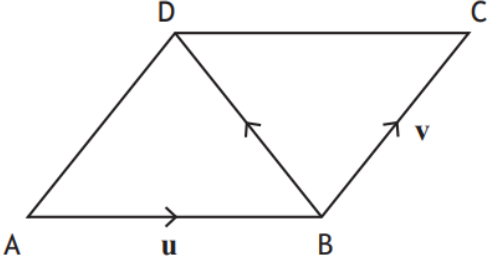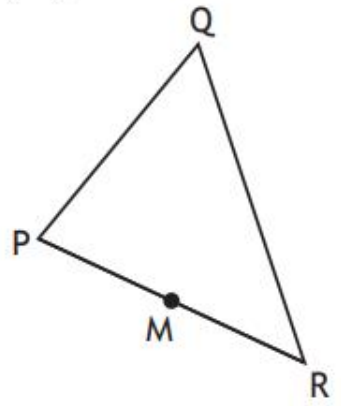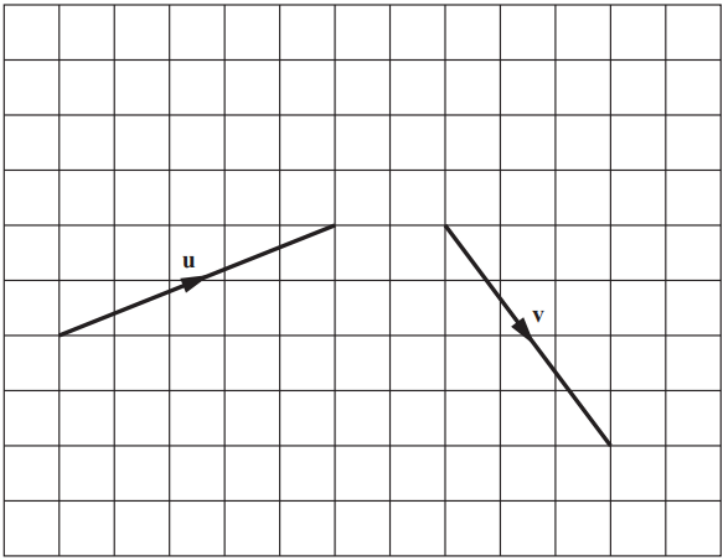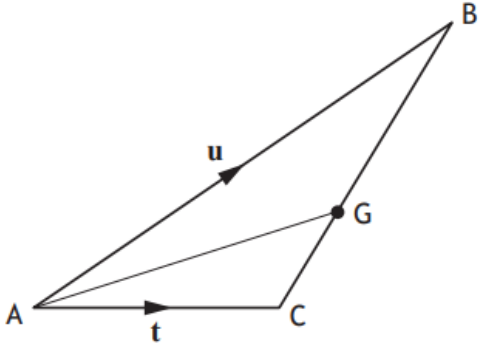
National 5 Maths
Vectors
Course content
- Adding or subtracting 2D vector pathways using directed line segments
- Adding or subtracting 2D or 3D vectors using components
- Calculating the magnitude
 of a 2D or 3D vector.
of a 2D or 3D vector.
Magnitude
Magnitude means length.
The magnitude of a vector \(\boldsymbol v\) is written in print as \(\vert\boldsymbol v \vert\) and in handwriting as \(\vert\underline v \vert\small.\)
Similarly, the magnitude of \(\small\overrightarrow{\textsf{AB}}\) is written as \(\vert\small\overrightarrow{\textsf{AB}}\normalsize\vert\small.\)
If a vector is given in component form, we can use either 2D or 3D Pythagoras to find its magnitude.
Textbook page references
- Zeta National 5+ Maths
 pp.234-249
pp.234-249 - TeeJay Maths Book N5 pp.141-152
- Leckie National 5 Maths pp.312-327
Notation
- \( \small \overrightarrow{\textsf{AB}} \normalsize\) represents the vector from point A to point B.
-
Lower case letters are also used to represent vectors.
- In handwriting, they are underlined, like this: \( \underline u \)
- In print, they are in bold, like this: \( \boldsymbol u \)
Key idea
- For any three points A, B and C, \( \small \overrightarrow{\textsf{AC}} = \overrightarrow{\textsf{AB}} + \overrightarrow{\textsf{BC}} \normalsize \).
- Think of this as going from A to B and then continuing from B to C. In other words: from A to C via B.
- It's the same resultant journey whether we go via B or not. We start at A and end at C, so the vectors are equal. Vectors only care about the end-points, not the pathway.
N5 Maths revision course
National5.com self-study courseSave £10 with discount code 'Maths.scot'
Example 1 (non-calculator)
In the diagram below, \( \boldsymbol u \), \( \boldsymbol v \) and \( \boldsymbol w \) represent \( \small \overrightarrow{\textsf{AB}} \normalsize\), \( \small \overrightarrow{\textsf{BC}} \normalsize\) and \( \small \overrightarrow{\textsf{AC}} \normalsize\) respectively.

Express \( \boldsymbol v \) in terms of \( \boldsymbol u \) and \( \boldsymbol w \).
Example 2 (non-calculator)
PQRS is a trapezium with \( \small \overrightarrow{\textsf{RQ}} \normalsize = 2\tiny\ \small \overrightarrow{\textsf{SP}} \normalsize \).
\( \small \overrightarrow{\textsf{PQ}} \normalsize \) and \( \small \overrightarrow{\textsf{RQ}} \normalsize \) represent vectors \( \boldsymbol u \) and \( \boldsymbol v \) respectively.

(a) Express \( \small \overrightarrow{\textsf{RP}} \normalsize \) in terms of \( \boldsymbol u \) and \( \boldsymbol v \).
(b) Express \( \small \overrightarrow{\textsf{RS}} \normalsize \) in terms of \( \boldsymbol u \) and \( \boldsymbol v \). Give your answer in its simplest form.
Example 3 (non-calculator)
Given \( \boldsymbol u = \left( \begin{matrix} -4 \\ \phantom{-}5 \end{matrix} \right) \) and \( \boldsymbol v = \left( \begin{matrix} \phantom{-}3 \\ -1 \end{matrix} \right) \), find:
(a)\( \:\:\ \boldsymbol u + \boldsymbol v \LARGE \phantom{G} \normalsize \)
(b)\( \:\:\ \boldsymbol u - \boldsymbol v \LARGE \phantom{G} \normalsize \)
(c)\( \:\:\ 2\boldsymbol u - 3\boldsymbol v \LARGE \phantom{G} \normalsize \)
(d)\( \:\:\ \frac{1}{2} \boldsymbol u + \boldsymbol v \LARGE \phantom{G} \normalsize \)
Recommended student book
Zeta Maths: National 5 Maths TextbookExample 4 (non-calculator)
Given \( \boldsymbol p = \left( \begin{matrix} \phantom{-}3 \\ -2 \\ \phantom{-}1 \end{matrix} \right) \) and \( \boldsymbol q = \left( \begin{matrix} \phantom{-}5 \\ \phantom{-}0 \\ -3 \end{matrix} \right) \), find:
(a)\( \:\:\ 2\boldsymbol p - \boldsymbol q \LARGE \phantom{G} \normalsize \)
(b)\( \:\:\ \frac{1}{2}\left(\boldsymbol p - \boldsymbol q \right) \LARGE \phantom{G} \normalsize \)
Example 5 (calculator)
Find \( \vert \boldsymbol v \vert \), the magnitude of vector \( \boldsymbol v = \left( \begin{matrix} \phantom{-}45 \\ -28 \end{matrix} \right) \).
Find a Maths tutor

Do you need a National 5 Maths tutor?
Click here to find a tutor in your area. ![]()
Example 6 (calculator)
Find \( \vert \boldsymbol r \vert \), the magnitude of vector \( \boldsymbol r = \left( \begin{matrix} \phantom{-}8 \\ -19 \\ -4 \end{matrix} \right) \).
Example 7 (non-calculator)
Find \( \vert \boldsymbol a - \boldsymbol b \vert \), where \( \boldsymbol a = \left( \begin{matrix} \phantom{.}5\phantom{.} \\ \phantom{.}6\phantom{.} \\ \end{matrix} \right) \) and \( \boldsymbol b = \left( \begin{matrix} \phantom{.}9\phantom{.} \\ \phantom{.}4\phantom{.} \\ \end{matrix} \right) \). Express your answer as a surd in its simplest form.
Example 8 (non-calculator)
The diagram shows a rectangular-based pyramid, relative to the coordinate axes.

B is the point (8,6,0).
The apex D is directly above the centre of the base.
The height of the pyramid is 7 units.
(a) Express \( \small \overrightarrow{\textsf{AC}} \normalsize\) in component form.
(b) Express \( \small \overrightarrow{\textsf{AD}} \normalsize\) in component form.
(c) Determine the exact value of \( \vert \small \overrightarrow{\textsf{AD}} \normalsize \vert\small.\)
Recommended revision guides
How to Pass National 5 MathsBrightRED N5 Maths Study Guide
Example 9 (calculator)
SQA National 5 Maths 2016 P2 Q3
The diagram below shows parallelogram ABCD.

\(\small \overrightarrow{\textsf{AB}}\) represents vector \(\boldsymbol u\) and \(\small \overrightarrow{\textsf{BC}}\) represents vector \(\boldsymbol v\small.\)
Express \(\small \overrightarrow{\textsf{BD}}\) in terms of \(\boldsymbol u\) and \(\boldsymbol v\small.\)
Example 10 (calculator)
SQA National 5 Maths 2018 P2 Q10
In the diagram below, \(\small \overrightarrow{\textsf{AB}}\) and \(\small \overrightarrow{\textsf{EA}}\) represent the vectors \(\boldsymbol u\) and \(\boldsymbol w\) respectively.

• \(\small \overrightarrow{\textsf{ED}}=2\small\,\overrightarrow{\textsf{AB}}\)
• \(\small \overrightarrow{\textsf{EA}}=2\small\,\overrightarrow{\textsf{DC}}\)
Express \(\small \overrightarrow{\textsf{BC}}\) in terms of \(\boldsymbol u\) and \(\boldsymbol w\small.\)
Give your answer in its simplest form.
N5 Maths practice papers
Non-calculator papers and solutionsCalculator papers and solutions
Example 11 (non-calculator)
SQA National 5 Maths 2019 P1 Q10
In triangle PQR, \(\small\overrightarrow{\textsf{PR}}=\left( \begin{matrix} \phantom{-}6 \\ -4 \end{matrix} \right)\) and \(\small \overrightarrow{\textsf{RQ}}=\left( \begin{matrix} -1 \\ \phantom{-}8 \end{matrix} \right)\small.\)

(a) Express \(\small\overrightarrow{\textsf{PQ}}\) in component form.
M is the midpoint of PR.
(b) Express \(\small\overrightarrow{\textsf{MQ}}\) in component form.
Example 12 (non-calculator)
SQA National 5 Maths 2021 P2 Q5
The vectors \( \boldsymbol u \) and \( \boldsymbol v \) are shown in the diagram below.

Find the resultant vector \( \boldsymbol u - \boldsymbol v\small.\)
Express your answer in component form.
Example 13 (calculator)
SQA National 5 Maths 2021 P2 Q17
The triangle ABC is shown below

\(\small\overrightarrow{\textsf{AB}}\normalsize =\boldsymbol u\) and \(\small\overrightarrow{\textsf{AC}}\normalsize=\boldsymbol t\small.\)
G is the point such that CG = \(\large\frac{1}{3}\)CB.
Express \(\small\overrightarrow{\textsf{AG}}\) in terms of \(\boldsymbol u\) and \(\boldsymbol t\small.\)
Give your answer in simplest form.
Example 14 (non-calculator)
SQA National 5 Maths 2024 P1 Q4
Given \( \boldsymbol a = \left( \begin{matrix} \phantom{-}3 \\ \phantom{-}4 \\ -1 \end{matrix} \right) \) and \( \boldsymbol b = \left( \begin{matrix} 5 \\ 3 \\ 2 \end{matrix} \right)\small, \) find the resultant vector \(3\boldsymbol a + \boldsymbol b\small.\) Express your answer in component form.
Need a Nat 5 Maths tutor?
Just use this handy little widget and our partner Bark.com will help you find one.
Maths.scot worksheet
| • Vectors worksheet • Answer sheet • See all National 5 Maths worksheets |
Past paper questions
| • All past paper questions by topic |
|
Vector pathways: • 2016 Paper 2 Q3 • 2017 Specimen Paper 1 Q11 • 2017 Paper 2 Q8 • 2018 Paper 2 Q10 • 2021 Paper 2 Q17 • 2024 Paper 2 Q14 |
| Vector components: • 2014 Paper 1 Q4 • 2015 Paper 2 Q5 • 2016 Paper 1 Q1 • 2018 Paper 1 Q4 • 2019 Paper 1 Q10 • 2021 Paper 2 Q5 • 2024 Paper 1 Q4 |
| Magnitude: • 2015 Paper 2 Q4 • 2017 Specimen Paper 1 Q3 • 2017 Paper 2 Q1 • 2018 Paper 2 Q3 • 2019 Paper 2 Q2 • 2021 Paper 1 Q1 |
Other great resources
| Videos - Maths180.com |
| Videos - Mr Graham Maths 1. Introduction to vectors 2. Alternative routes 3. Magnitude of a vector 4. Scalar multiplication 5. Vector pathways |
| Video - Mr Hamilton Online Resultant and magnitude |
| Videos - YouKenMaths 1. 2D vectors 2. Vector journeys: 1 of 4 3. Vector journeys: 2 of 4 4. Vector journeys: 3 of 4 5. Vector journeys: 4 of 4 6. Worked examples |
| Notes and videos - Mistercorzi 1. 2D vectors 2. 3D vectors |
| Theory guide - National 5 Maths |
| PowerPoint - MathsRevision.com |
| Detailed notes - BBC Bitesize 1. 2D vectors 2. Vector components 3. Magnitude of a vector |
| Notes - National5.com |
| Notes - D R Turnbull |
| Lesson notes - Maths 777 1. Vector arithmetic, resultant 2. Magnitude of a vector |
| Notes and examples - Maths Mutt |
| Practice questions - Maths Hunter |
| Worksheet - Cumnock Academy |
| Essential Skills worksheet Vectors worksheet (Answers) |
| Exercises - Larkhall Academy Pages 19-32 Ex 1-8 |

Click here to study the vectors notes on National5.com.
You may also want to check out their Nat 5 Maths self-study course. We think it's excellent. If you decide to enrol, just use coupon code "Maths.scot" to get £10 discount.
|
⇦ Nat 5 topic list ⇧ Top of this page
|
